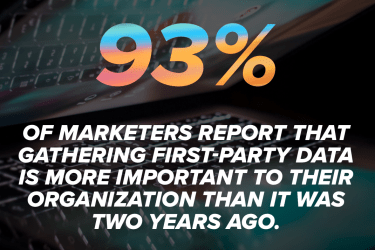How to Develop and Implement a First-Party Data Strategy

For marketers, the cookie began crumbling in 2018 and will be nothing but dust by the end of 2023.
Of course, we’re talking about third-party cookies, the tracking files generated by website domains other than your own. Safari and Firefox phased them out a while back, but it wasn’t until Google announced that it would no longer support third-party cookies on Chrome that marketers began panicking. The anxiety makes sense: The three browsers ate up 86% of global market share for browsers between June 2021 and June 2022, according to Statcounter, with Chrome accounting for 63% of the total.
Keep calm and carry on, marketers. As long as you’ve got a first-party data strategy and the tools to implement it, you’ll be more than prepared when third-party cookies go away. Let’s talk, then, about how to develop that strategy and how to execute it.
Cookies vs. data: What’s the difference?
Before we discuss strategy, let’s clarify key concepts, like the difference between a cookie and data.
Cookies are small digital files that a website stores on your device to gather information about your browsing history. They collect data but aren’t data themselves, per se. When the cookie is on your site, it’s called a first-party cookie, and the information it tracks — such as analytics around user behavior — isn’t shared with other websites.
Third-party cookies, on the other hand, are created on one site and shared across all third-party domains with the same tracking code. So, when you check out a website other than your own, the third-party cookie notes your visit and sends the information to the third party — often an advertiser — that created the cookie.
How do they work in practice? Say you peruse Nike’s website and click on a pair of Air Jordan low-tops. That act creates a cookie that’ll be stored on your browser. Then, when you open Instagram later, the cookie will be used to show you ads for those very shoes. That kind of advertising and retargeting has been called creepy and annoying, and it’s why browsers like Safari, Firefox, and Chrome began phasing out third-party cookies. Turns out data privacy for both browsers and, increasingly, regulators is king.
Defining zero-, first-, second-, and third-party dataZero-party data is information that a user volunteers, like their name and email address. No cookies are involved in the acquisition. First-party data is information acquired by cookies your organization has on its site(s), such as how long a visitor stays on a page. Second-party data is first-party data owned by another entity that chooses to sell or share the information. Third-party data is information acquired by third parties, such as adtech companies, through cookies they apply to sites across the web. |
First- and third-party cookies are really the only kind of cookies that exist. What they represent are kinds of data. First-party data is information you own exclusively because you’ve compiled it from your site; third-party data is any information that’s collected or shared from a third party with no direct connection to the source, such as a consumer.
Related are zero- and second-party data. Zero-party data is information volunteered by a user, such as when they enter their name and email address when signing up for your newsletter. Second-party data is first-party data collected by a partner who wants to share or sell it to you. For instance, a cruise line may share its first-party data with a tour operator because of the synergy between the businesses.
Why is first-party data important?
Organizations are now laser-focused on first-party data not only because third-party cookies are going away, but because it’s information within their control — the websites and other digital properties they own. Zero-party data often gets conflated with it because the methods for gathering that information typically involve direct engagement with users, such as conducting polls on social media or distributing surveys in exchange for a coupon or discount.

But organizations are also placing greater emphasis on first-party data because it’s richer. Sure, third-party cookies can tell you if a potential customer looked at a lawnmower featured on a certain website and then allow you to target that same consumer with ads for it on other sites and platforms — but that’s just one data source. What about all the other actions potential and existing customers take, like what they buy at your brick-and-mortar locations or the pages they return to on your site over and over again? That information is specific to your audience, giving you valuable and proprietary insights that competitors can neither access nor replicate.
How to develop a first-party data strategy
Developing a first-party data strategy doesn’t have to be difficult. Follow the five steps below and you’ll be on your way.
1. Define your goal(s)
Developing any strategy begins with knowing your objectives. Do you want to reduce churn? Expand your loyalty program? Move overstocked inventory or enrich the customer experience?
Take a step back and identify which goals should be prioritized. Are any at cross purposes? Aligning stakeholders promotes a shared investment in the strategy and outcomes.
2. Decide which data matters
Once you’ve established your goals, determine the data you need to reach them. Do you already have the data? If not, how might you go about getting it?
For instance, if you want to establish a loyalty program (retaining customers is cheaper than acquiring new ones, after all), do you know who your repeat customers are? Of those, do the in-store shoppers differ from those who buy online? Maybe they’re older or buy more or less of a certain product. How might you personalize or tailor your offers to them based on that data?
Once you’ve decided which data to elevate, you can then choose among different incentives based on it, such as access to exclusive content or free shipping.
3. Earn customer trust
Consumer trust is key to business success because it drives loyalty, positive reviews and testimonials, and, ultimately, revenue. To earn that trust, brands must have clear data policies in place that are apparent to internal and external stakeholders alike. Indeed, a 2023 PricewaterhouseCoopers survey found that approximately seven out of 10 respondents ranked the disclosure of data privacy policies as “very important.”
With that in mind, brands could fold consent forms into the user experience, apply progressive profiling, and other data governance that allows audiences to control their data and ensures they understand that their information is being used responsibly. In turn, organizations encourage data integrity and usability.
4. Identify your success metrics
Metrics that signal your success or where you could improve will naturally vary depending on your objectives. The key is knowing in advance what those metrics are so you can ensure that the mechanisms needed to track and report on them are in place. For example, according to a 2023 Econsultancy report, only 29% of survey respondents felt that their organization has a robust measurement system in place for the coming cookieless future.
Figure out what will best indicate progress for your organization and confirm that those metrics can be tracked when you implement your strategy.
5. Assess your marketing technology
You’re itching to start acting on these decisions, but do you have the tools you need to not only compile the data but to unify it and execute the tactics that stakeholders approved? According to a 2022 MMA and BCG survey, marketers are planning to tweak their marketing technology (martech) investments because of tracking and regulatory changes, with interest greatest in marketing cloud platforms and customer data platforms (CDPs).
Those particular technologies are understandably attracting attention because they solve many of the challenges that a cookieless future threatens. For example, a marketing cloud platform like Acquia’s offers multiple solutions. With tools such as Acquia CDP, Personalization, Campaign Studio, Campaign Factory, and Acquia Digital Asset Management (DAM) and Product Information Management (PIM), organizations can easily design omnichannel experiences that break down data silos to deliver hyper-relevant customer journeys across all touchpoints.
There are a la carte options too — you can break off just the Acquia CDP, for instance. The platform allows you to bring order to a chaotic data environment by unifying various data sources into a single customer profile. Plus, Acquia CDP’s Identity Resolution Engine is baked in, so you don’t have to purchase a separate identity resolution solution. With a CDP in place, you can quickly begin to act on your strategy and start delivering the tailored, personalized experiences that customers crave.
And if the idea of implementing a CDP is a bit intimidating, we’ve got a guide that can help. We also know that organizations may still be at the exploratory stage, so here are a few free resources to turn to:
- How to Choose a Customer Data Platform
- A Marketer’s Guide to Customer Data Platform Use Cases
- 4 Types of Customer Data Platform: Which Is Right for You?
- Optimizing the Customer Journey with a CDP
6. Ensure coordinated implementation
For your strategy to succeed, marketing and sales data processes must align with those of other departments — IT, operations, and so forth. Make sure your implementation plans include:
- Clear-cut insight requirements, such as establishing governance, identifying processes, and capturing the voice of internal customers.
- Data management. First, audit your current data. Then, acquire and unify it (again, a CDP easily facilitates this step), curate it, and measure results.
- Team enablement. Ensure that your organization has a data-privacy compliance strategy that covers data intake, storage, usage, maintenance, and disposal. Specialized staff can help meet these goals as can technologies like CDPs and analytics tools that track compliance with first-party data policies.
The elements above will ensure your organization cultivates data quality, simplifies policy compliance, and elicits trust and loyalty among customers.
Execute, rinse, repeat
With your objectives in sight and the tools in place to reach them, the last step is executing the tactics you decided on. You’ll monitor their performance, doubling down on what’s working and revising what needs work. Then, it’s simply a matter of repeating these steps and patting yourself on the back for being so prepared. Indeed, companies that describe themselves as well-prepared for the changes ahead have elevated their investments in first-party data and the technologies that support revised marketing strategies, according again to the MMA and BCG survey.
It won’t be long before all of the big platforms retire third-party cookies. Develop and begin testing a first-party data strategy before that happens to stay ahead of competitors. Want to be even better prepared? Check out our free e-book: The Evolution of Digital Experience in a Cookieless World.

